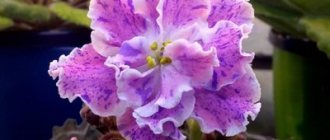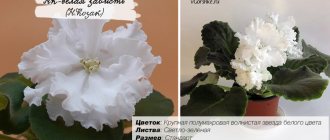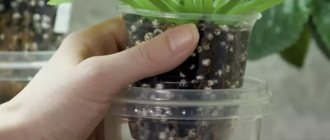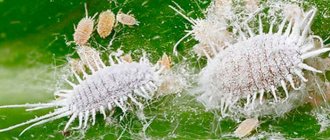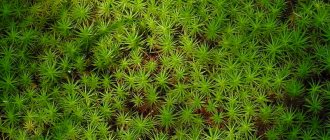When growing violets, you should pay attention to many aspects, among which the quality of the soil is one of the first places.
A properly selected substrate is essential for good plant growth and development. In this article we will look at Klassman peat for violets - which is better and why?
Klassman peat for violets
Among the nutrient mixtures that are suitable for growing violets, Klassmann TS1-085 peat (originally Klasmann TS1-085) occupies a special place. Its mechanical properties and balanced composition will help you achieve excellent results when cultivating your favorite flower.
This completely ready-to-use nutrient substrate based on white high-moor peat is most suitable for cultivating violets, gloxinias, etc.
Klasmann TS1-085 is excellent for growing violets.
Description
High-moor peat itself is characterized by a low degree of decomposition, low content of mineral elements, and high acidity.
The optimal level of pH (acidity) and nutrient content for plants is achieved by applying lime and fertilizers. The peat mixture also includes:
The developed nutrient mixture provides the plant:
Thanks to the structure of peat, the roots of the violet will constantly be in a humid environment and at the same time will not lack oxygen . This promotes rapid development of the root system and violet growth.
Peculiarities
On the market, the Klasmann TS1 peat mixture is presented in several formulations , which differ in the size of the fractions of the peat included in their composition:
Each recipe has its own purpose in crop production.
Peat mixture Klasmann TS1-085 is characterized by the following indicators:
Characteristics of Klasmann TS1-085.
Recommendations for use
This substrate is ideal for growing violets on wick irrigation:
Agrochemical indicators
The substrate already has a balanced composition of macroelements (nitrogen, phosphorus, potassium), suitable for various crops.
If necessary, it can be used as a base by adding perlite, expanded clay, etc.
Peat mixture characteristics:
Mineral elements:
The moisture capacity of the substrate is 75-80%, the air capacity is 11-15%, the weight in terms of dry matter is 10%.
This characteristic allows you to create highly nutritious mixtures for a wide range of plants .
Necessary soil for violets with your own hands.
No matter what quality of soil mixture you purchase, there is always a need to add raising agents. That is why it is recommended to make the composition yourself, so to speak, with your own hands.
Let's consider two ways to obtain the necessary soil:
1) Baking powder and peat. For bottom soil, it is necessary to systematically add the entire useful composition. 2) Complex mixtures - soil, which includes the entire list of nutrition necessary for violets.
It is important to remember that all components for soil, naturally except fertilizers, undergo mandatory sterilization. It is easier and more convenient to do this in the following way: treat with a chemical composition. A safer and more convenient way is to heat it in the oven, pour boiling water over it, and freeze it in the freezer. Of course, all these processes will take more time, but it is environmentally safe for plants and humans.
After thermal treatment of the soil, it is necessary to use a solution of Fitolavin-300 or Trichodermin. How to explain? Completely sterile soil can easily absorb all microbes, bacteria, and spores of various fungi from neighboring plants, and the reproduction of these parasites occurs most rapidly when the soil is sterile. These drugs are useful microorganisms with which you populate the soil; they are capable of independently fighting all pathogens.
Every experienced gardener has a number of excellent recipes for creating optimal soil.
Below we list the recommended compositions:
- peat + 50% required soil + 20% perlite + 20% moss + 10% soil of good nutritional composition + charcoal;
- nutritionally enriched soil 70% + moss 10% + perlite 10% + 10% charcoal;
- nutritious soil and peat in a ratio of 1:3 + 1 part perlite and charcoal.
Many people use additional additives of folk origin: ground eggshells, compost, dolmite flour, soil with pine needles, river sand. All these components add a certain looseness to the soil, good air exchange, and excellent water permeability. Although without these components, the listed compositions can create ideal conditions for growing violets. The rest is just an addition and is used at the discretion of each person.
You can prepare the soil for future use, just follow proper storage: place it in a box or other container, cover the inner layer of the container with polyethylene and then place the substrate there. Close the lid. The soil should be checked periodically to avoid drying out, and it is advisable to limit the access of air flow.
Recipes for Klassmann peat-based substrates for violets
Based on this peat mixture, various substrates are prepared, suitable for violets of different ages, but not only.
Klassman can be the basis for self-production of soils.
Various additives can be added as desired. This can be agroperlite, expanded clay, etc. The peat/perlite ratio is selected for different age categories of violets:
It is better to mix peat mixture with perlite.
It is better to buy large perlite and be sure to rinse it before use. There is a lot of dust on it, which binds the substrate, significantly worsening its properties.
Review
Zhanna, Blagoveshchensk. “Klasmann peat is now in vogue among gardeners. So I decided to buy some violets for my own. I came across a small package, only 1 kg. Violets grow beautifully on it, bloom almost all year round, and look amazing. But on other mixtures they also grew well for me.”
Antonina, Mogilev. “About six months ago, Klasmann substrate was delivered to one of our flower shops. Since this soil only comes in large packages of 200 liters, it was divided into bags and sold at a very low price. I took a special one for violets. The flowers are growing well, I tried to plant cuttings - they all gave birth to babies. I transplanted my entire collection into a special composition with 30% perlite and placed it on a wick. I’m happy with everything.”
Margarita, Barnaul. “I planted all the violet cuttings in Klasmann TS1. Peat is unusually light and airy. On the advice of experienced gardeners, I mixed it with perlite, adding a third of the total share. I planted cuttings, they developed babies quite quickly, and soon they can be planted. The substrate is excellent, the flowers grow wonderfully. I will transfer all the flowers to this soil.”
Everything you need to know about violet soil
Do you know what soil is suitable for your violets? After all, how well the plant will develop depends on the correct soil.
It must combine the necessary nutritional value and the correct acidity. The soil must be loose enough to provide the roots with the necessary air exchange.
If the soil mixture is chosen incorrectly, the plant may become very sick or even die completely . Later in the article we will look at what kind of soil is good and how to compose it correctly.
Klasmann TS 4
| Klasmann TS 4 (250 l; 5.8 m3) Klasmann TS 4 substrates are mainly based on a combination of low-decomposition Lithuanian milled peat and coarse fractions obtained from carved peat. All these substrates are characterized by high air content, as well as high stability of the substrate structure. TS 4 Medium is ideal for growing potted plants in pots ranging from 11 to 18 cm in size. TS 4 Medium + Perlite (603) is designed for ebb and flow systems. Klasmann TS 4 Coarse was developed specifically for growing ornamental foliage plants in containers larger than 2 liters. Recipe No. | Product | Structure | Granular clay clay | pH (CaCl) | pH (H2O) | Enrichment | Recommended scope of application |
| 602 | TS 4 | Average 10-30 mm | 5,5 | 6,0 | 1.0 kg/m3 | Growing flowering and decorative foliage plants | |
| 604 | TS 4 | Rough 10-45 mm | 5,5 | 6,0 | 1.0 kg/m3 | Growing decorative foliage plants in pots larger than 2 liters | |
| 335 | TS 4 | Rough 10-45 mm | Granulated Clay 20 kg/m3 | 6,0 | 1.0 kg/ |
Peat substrate Klasmann TS 4 medium cuttings recipe 686
Fine white peat with the addition of perlite.
Peat with a fine structure for growing seedlings of vegetable and flower crops.
What kind of soil is needed for violets?
Choosing the right soil is quite simple if you know what kind of soil is needed for flowers, what acid-base balance is required, and what composition it should have to ensure the necessary looseness.
Soil composition
The soil at home for Saintpaulias should consist of leafy and coniferous soil , which conduct moisture and air well, turf or high-moor peat.
Be sure to add nutritious vermicompost , which provides the plant with all micronutrients. But it makes the soil heavier; vermiculite or perlite will help correct this.
of river sand will help retain moisture well . coconut substrate to increase moisture and air exchange
Acid-base balance
When studying what kind of soil violet likes, you should pay attention that the pH level of the soil should be kept in the range of 5.5 - 6.5. When the indicator decreases or increases, the life process of the plant is disrupted. It will not receive enough minerals.
Ready-made earthen mixtures for Saintpaulia have the required pH level, which is indicated on the package. To determine the acidity of the earth, special test strips are sold.
Determination of soil acidity.
Looseness
What kind of soil does violets need to grow well? First of all, air and water permeable. To increase these indicators, you can add to the soil mixture:
Klasmann TS 3
| TS 3 is produced on the basis of milled peat. The degree of decomposition of this peat lies within the NZ-H6 range of the European classification, which means that this moderately decomposed peat was extracted from fields where the extraction of young milled peat has already been completed. Due to the initial characteristics of this peat, TS3 substrates have increased moisture capacity. Therefore, these substrates should be used in arid climatic zones with an average daily temperature above +40C. To grow plants in beds in bags, you can use the substrates TS 3 Standard (425) TS 3 Standard plus Granulated clay (404). For growing especially valuable plants in beds, for example, Impatiens New Guinea Hybrids, Surfinia, pelargoniums, fuchsias, primroses and violets, TS 3 Medium plus Granulated clay (607) is optimal. Recipe No. | Product | Structure | Granular clay | pH (CaCl) | pH (H2O) | Enrichment | Recommended scope of application |
| 416 | TS3 | Fine 0-5 mm | 5,5 | 6,0 | 1.0 KG/M3 | Growing plants in containers | |
| 425 | TS3 | Standard 0-25 mm | 5,5 | 6.0 | 1.0 kg/m3 | Picking and planting plants and group plants in bags and pots with a diameter of up to 11 cm | |
| 404 | TS3 | Standard + clay 0-25 mm | 20 kg/m3 | 5,5 | 6,0 | 1.0 kg/m3 | Planting plants in bags and pots with a diameter of up to 11 cm |
| 607 | TS3 | Medium + clay 0-25 mm | 20 kg/m3 | 5,5 | 6,0 | 1.0 kg/m3 | For growing plants in large pots and flowerpots. Substrate with increased structural stability is ideal for vertical gardening |
Peat substrate Klasmann TS 3 standard formulation 601
Peat substrate of medium fraction (0-25 mm) consisting of white (0-25 mm), white turf (10-25 mm) and white transition (0-25 mm) H3-H6
Peat substrate for flowering plants and green shrubs. With wetting agent.
Chemical properties: Nutrients:
pH value (H2O, v/v 1:2.5): 6.0 nitrogen (mg N/liter) 140
Fertilizer (g/l): 1.0 phosphorus (mg P2O5/liter) 100
potassium (mg K2O/liter) 180
magnesium (mg MgO/liter) 100
+ with all trace elements of iron as intra-complex EDTA
(ethylenediaminetetraacetic acid, Trilon B)
Physical properties:
- Dry matter (10%)
- Moisture capacity (73-78%)
- Air capacity (12-17%)
Variations correspond to quality standards for crop growing substrates
Recommendations Klasmann
| Pot size | Directions (recommendations) | Cultures |
| more than 1.5 l | Peat substrate for flowering plants and green shrubs. With wetting agent. | Flowering plants Green bushes Bushes |
Recommendations: This substrate is recommended to be used as the main substrate for growing cut lilies.
This substrate is suitable for growing cyclamen in 1.5-2.0 liter pots
Components for DIY
Despite the large number of ready-made soils, many gardeners prefer to prepare their own soil mixture , mixing the components in a suitable ratio.
Components can also be purchased separately in specialized stores. This way, you don’t have to run around the shops looking for which soil is suitable for violets.
Do-it-yourself soil for violets can be prepared from the following components:
Vermicompost is used as fertilizer.
Before you prepare the soil yourself, purchase the indicated components.
Composition of soil for violets at home based on ready-made soil. The addition of these substances helps enrich the finished mixtures:
Another recipe based on ready-made soil:
Recipe
based on a universal soil mixture for indoor plants with a neutral pH:
Recipe for preparing soil based on lowland and high-moor peat:
Sod and leaf soil
Turf and leaf soil can serve as a nutrient basis for the soil. They replace universal primer. Unlike peat, they can be obtained independently in field meadows. To do this, remove the top layer of soil by 2-5 centimeters.
Leaf soil is the top layer of soil with fallen rotted leaves under linden, fruit trees or maple. Used as an additive to turf soil.
How to prepare your own soil mixture?
If you decide to make your own primer, study the composition that is needed for different cases. For example, in the case of wick irrigation, special requirements will be placed on the soil.
For wick irrigation
We have already determined what kind of soil violets like, but we will not forget to repeat that the soil used for wick irrigation should:
Therefore, it is worth enriching the purchased mixture with vermiculite, agroperlite, and sphagnum moss.
Disinfection
The ready-made store-bought mixture is completely sterilized before sale, so it does not require disinfection, but you can add a little crushed charcoal to it.
If you collected the soil yourself, it needs to be calcined in the oven for several hours.
Methods of growing in soilless soil: pros and cons
When studying the question of which land to choose for growing violets, some gardeners settle on the landless option. This mixture is based on peat or coconut substrate with the addition of raising agents.
It is distinguished by a complete lack of nutrients , which are introduced independently with the help of fertilizers. It is often used for wick growing of Saintpaulia.
The advantages include the complete absence of pathogens. But due to the lack of nutrients, they must be constantly supplied from the outside, so this method is only suitable for wick irrigation.
Necessary fertilizer for violets.
The presence of the required amount of moisture, light lighting, compliance with the temperature regime are all important indicators for the full cultivation of violets. But! One of the first criteria is high-quality, timely nutrition with the necessary elements (fertilizers).
Of course, the plant consumes the entire set through the root system from the soil composition, but over time this amount of nutrients is depleted when consumed by the violet or is simply washed away during watering. This flower simply needs additional fertilizers; without them, violets slow down the developing process, the lack of elements affects the external and internal condition of the plant.
There are two most consumed types of fertilizer: 1) minerals; 2)organic.
The texture of the additives is different - granular, in the form of sticks, in a liquid state. We choose for ourselves which type is better and more convenient to work with.
Important point!!! It is strictly prohibited to use fertilizers without reading the instructions for use and the presence of restrictions for their use. Ignorance can lead not only to the death of the plant, but also to harm to humans, internal or external. From skin disorders to body poisoning. For the safety of the plant, it is necessary to comply with the recommended dosages.
We will consider several necessary and easy-to-use additives of organic and mineral composition: - NITROGEN - its presence is necessary especially for young violet bushes, it can strengthen the green mass; -PHOSPHORUS - the plant needs the element during active budding and with abundant flowering; -POTASSIUM - the presence of this drug contributes to the duration of flowering; -Amino acids and Vitamins - when these are added, the most productive consumption of nutrients by the plant begins, and their absorption is also enhanced.
It is always necessary to follow the rules for applying any type of fertilizing: -only apply the entire nutritional composition from above; - the process of applying fertilizing and the choice of dosage is important even with the slightest deviation from the norm, therefore it is better to give the violet less fertilizer than to oversaturate it with this composition, as a result of which regression in development may begin; - strict familiarization with the instructions and mandatory compliance with all points thereof; - you need to establish a timely feeding system and adhere to this scheme; - it is recommended to periodically change the soil by replanting it into a new one, since a set of fertilizers will not renew the composition of worn-out soil. Do not forget about the need to disinfect new soil; - the variety of various fertilizers is such that experienced gardeners recommend changing the composition periodically so that the plant does not develop habits. Then the substances will bring a less expected effect; -moisten the soil before applying fertilizer. It is not recommended to add additives to a dry substrate; -if the plant is a little sick at the time of feeding, do not apply fertilizers, leave this process until complete recovery. Already at that stage, the flower will need a dosage of nutrition to restore strength.
When you fully comply with all the recommendations and follow simple care rules, you can easily grow a beautiful, strong, beautiful, healthy plant, even from children or leaves. Young bushes are able to delight with their flowering for a long period.
